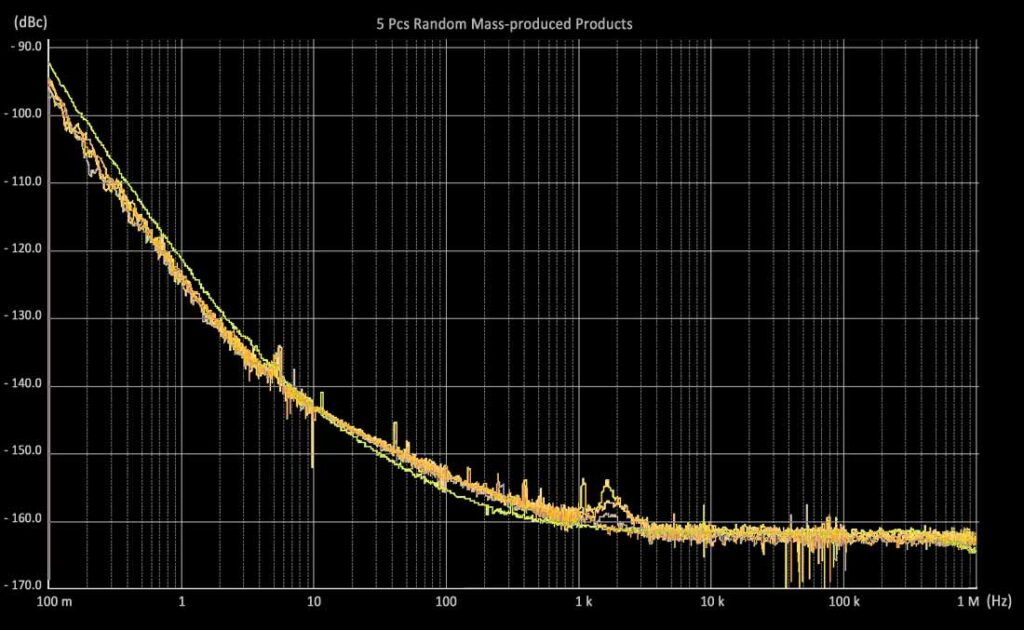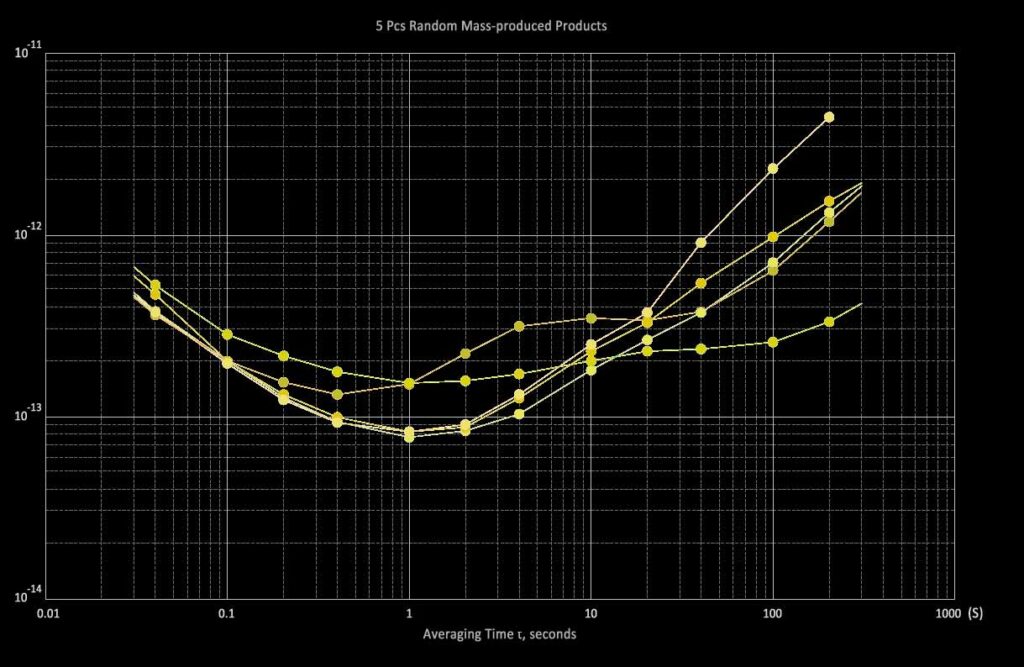An upgraded ultra-low-noise Master Clock to ensure perfect timing accuracy and lowest possible jitter for the most demanding audiophiles
Timing is everything
Starting with the advent of CDs in the 1980s, digital recording products and their playback devices have entered the homes of audiophiles. Today, various digital audio carriers such as CDs, SACDs, digital audio files, etc., along with various digital audio playback devices and software such as CD players, computers, playback software, digital-to-analog converters, and various audio formats with different resolutions, continue to update the music software, hardware, and systems in the hands of audiophiles. In the decades-long development of digital audio technology, a hurdle that cannot be avoided and must be overcome in the pursuit of higher sound quality is clock jitter.
Master Clock is King
In digital audio circuits or digital-analog hybrid audio circuits, the performance of clock jitter will vary not only due to the different quality of each digital device, but also due to the accumulation of quality differences in several digital devices in the system. Clock jitter has a negative impact on subjective listening, typically causing blurriness in sound imaging, looseness and loss of power in the low-frequency range, and lack of transparency and depth in the high-frequency range. It is believed that many audiophiles have experienced this. Therefore, for decades, numerous audio equipment manufacturers have been striving to reduce clock jitter. The most common technical means are to improve the clock synchronization performance of each device itself (such as phase-locked loop circuits or crystal oscillators) or to develop an independent synchronization reference device, namely, the master clock. Today, as a Hi-End system that plays digital audio sources, the master clock has become a standard configuration. Having a master clock in their own system is also a dream of many audiophiles over the years.
NADAC C the new MF flagship Ultra Low Noise Master Clock

Double Aged Crystal Oscillator
The crystal oscillator core of NADAC C is based on highly stable SC cut crystal. It has been pre aged and screened for up to 120 days before being assembled into a crystal oscillator. After being assembled into a crystal oscillator, a long-term secondary aging test will be carried out to ensure that the quality of the crystal oscillator finally installed can meet the standards required by Master Fidelity. The peripheral parts such as resistors and capacitors used in the NADAC C distribution output circuit use high-performance pulse application models to ensure the perfect transmission and drive of the 10 MHz synchronous signal, as well as to ensure excellent cable drive capability. Thus avoiding cable transmission to the greatest extent introduced jitter and jitter triggered by the load circuit.
Ultra-Low Noise redefined
In NADAC C, in addition to the crystal oscillator itself using a constant temperature system, the power supply of the clock signal distribution circuit also adopts an ultra-low noise constant temperature reference plus current expansion power supply system, to ensure the purity of the 10 MHz signal after the distribution output. As the word clock part of NADAC C, because the frequency of 10 MHz is a non integer multiple relationship with the frequency of audio clock, we design the word clock part of NADAC C as a multi-level phase-locked processing structure, so as to ensure high frequency accuracy and excellent jitter performance when converting from 10 MHz to word clock. This means that there is not only one crystal oscillator in Clock, but also a high-quality voltage-controlled crystal oscillator with femtosecond jitter level for audio frequency clock synthesis is used in the audio frequency (word clock) generator, and the 10 MHz is used to provide a reference for the audio clock synthesizer, resulting in high accuracy and low jitter.
Legacy NADAC dedicated Output
NADAC C also has a 625 kHz clock output port, specifically designed to provide an external sync source for audio devices using a 625 kHz clock (such as the previous NADAC). In short, clock not only has excellent indicators of the crystal oscillator itself, but also has high-quality transmission characteristics through the overall design. For this reason, clock can ensure that the synchronization signal transmitted to each digital device in the system is of high quality. We hope this NADAC C can bring a new feeling to your music appreciation.

Specifications
| General Specifications | |
| Power supply | |
| Voltage and Frequency | AC 100 – 240 V, 50 / 60 Hz |
| Power Consumption | Maximum < 25 W;Stable 6 W (Typical) |
| Connectors | IEC 60320 C14 |
| Fuse | 0.5 A,5 x 20 mm Slow Blow |
| Dimensions and Weight | |
| Dimensions | 435 mm (W) x 95 mm (H) x 390 mm (D) |
| Weight | 9,2kg |
| Specifications | |
| Crystal | |
| Core Crystal Architecture | Selected High Stability Pre – Aged SC-Cut Crystal |
| Ageing | The crystal has been pre-aged for not less than 120 days before assembling the crystal oscillator, and the secondary aging after assembling into a finished crystal oscillator |
| Clock Output Specifications | |
| 10 MHz Clock Output | |
| Output Frequency | 10 MHz |
| Output Waveform | Square Wave (AC-Coupled) |
| Waveform Duty Cycle | 50% |
| Output Jitter (Typical) | 66 femtosecond @ 10 Hz ~ 100 kHz Bandwidth |
| Output Power | + 13 dBm @ 50 ohm Load |
| Short-Term Stability (Typical) | Tau = 1E-13 @ 1 second |
| Phase Noise (Typical) | – 122 dBc @ 1 Hz; – 140 dBc @ 10 Hz;- 150 dBc @ 100 Hz;- 155 dBc @ 1 kHz; – 160 dBc @ 10 kHz; -160 dBc @ 100 kHz; -160 dBc @ 1 MHz |
| Output Rise Time | 800 picosecond |
| Frequency Accuracy (Factory Calibration) | < 10 ppb |
| Connector | 6x BNC |
| Output Nominal Impedance | Recommended 50 ohm (75 ohm supported) |
| Word Clock Output | |
| Output Frequencies | 44.1 kHz,88.2 kHz,176.4 kHz,352.8 kHz,705.6 kHz,1411.2 kHz 48 kHz,96 kHz,192 kHz,384 kHz,768 kHz,1536 kHz |
| Output Waveform | CMOS |
| Waveform Duty Cycle | 50% |
| Output Amplitude | > 2.2 V @ 75 ohm Load |
| Output Jitter (Typical) | 250 femtosecond @ Carrier 1536 kHz, 10 Hz ~ 100 kHz Bandwidth |
| Output Rise Time | 600 picosecond |
| Frequency Accuracy (Factory Calibration) | < 10 ppb |
| Connector | 2x BNC |
| Output Nominal Impedance | 75 ohm (Compatible with 50 ~ 200 ohm) |
| 625 kHz Clock Output | |
| Output Frequency | 625 kHz |
| Output Waveform | CMOS |
| Waveform Duty Cycle | 50% |
| Output Amplitude | > 2.2 V @ 75 ohm Load |
| Output Jitter (Typical) | 100 femtosecond @ 10 Hz ~ 100 kHz Bandwidth |
| Output Rise Time | 800 picosecond |
| Frequency Accuracy (Factory Calibration) | < 10 ppb |
| Connector | BNC (6th port using 10 MHz clock output) |
| Output Nominal Impedance | 75 ohm |
Phase Noise of NADAC C 10 MHz Output

Short-Term Stability of NADAC C



